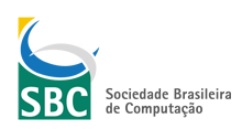Cooperative UAVs using multi-agent coordination techniques for search operations
Resumo
Este trabalho propõe um modelo multiagente de VANTs cooperativos para operações de busca e salvamento. As vantagens da utilização desse tipo de robô são: não exposição de pessoas a riscos; redução de custos; e a possibilidade de operar por longos períodos sem descanso. O modelo compreende a modelagem do conhecimento dos agentes, o planejamento individual de cada agente, a utilização de mecanismos de coordenação e a estratégia de cooperação. Simulações envolvendo dois VANTs cooperativos foram realizadas e, comparado ao tempo de busca de uma operação envolvendo duas aeronaves não cooperativas, observou-se uma redução do tempo de busca de 55% em média.
Referências
Bussmann, S. and Müller, J. (1993). A negotiation framework for cooperating agents. In Deen, S., editor, 1992 Proceedings of the Special Interest Group on Cooperating KnowledgeBased Systems, pages 1–17, Keele, UK. Dake Centre, University of Keele.
DECEA (2009). Manual de busca e salvamento (mca 64-3). Technical report, Comando da Aeronáutica.
Durfee, E. H. (1999). Distributed problem solving and planning. In Weiß, G., editor, Multiagent Systems: A Modern Approach to Distributed Artificial Intelligence, pages 121–164. MIT Press, Cambridge, MA, USA.
Georgeff, M. P. (1983). Communication and interaction in multi-agent planning. In Proceedings of the 3rd National Conference on Artificial Intelligence (AAAI-83), pages 125–129, Menlo Park, CA. AAAI Press.
IMO/ICAO (2003). International aeronautical and maritime search and rescue manual (iamsar manual). Technical report, International Maritime Organization and International Civil Aviation Organization, London, United Kingdom.
Jennings, N. R. and Wooldridge, M. (1998). Applications of intelligent agents, pages 3–28. Springer-Verlag New York, Inc., Secaucus, NJ, USA.
Lester, P. (2005). A* path finding for beginners. Acesso em 18/04/2012: [link].
Luck, M., McBurney, P., Shehory, O., and Willmott, S. (2005). Agent Technology: Computing as Interaction (A Roadmap for Agent Based Computing). AgentLink.
Martial, F. V. (1990). Interactions among autonomous planning agents. In In Demazeau, Y. and Müller, J.-P., editors, Descentralized AI - Proceedings of the First European Workshop on Modelling Autonomous Agents in a Multi-Agent World (MAAMAW-89), pages 105–120, Amsterdan, The Netherlands. Elsevier Science Publishers B.V.
Nwana, H., Lee, L., and Jennings, N. (1996). Coordination in software agent systems. British Telecom Technical Journal, 14 (4):79–88.
Pechoucek, M. and Sislak, D. (2009). Agent-based approach to free-flight planning, control, and simulation. IEEE Intelligent Systems, 24(1):14–17.
Pereira, A. H., Nardin, L. G., and Sichman, J. S. (2011). Coordination of agents in the robocup rescue: A partial global approach. In Anais do VWorkshop-Escola de Sistemas de Agentes, seus Ambientes e apliCações (WESAAC), pages 75–84, Curitiba, Brazil.
Ren,W. and Cao, Y. (2011). Distributed Coordination of Multi-agent Networks. Springer.
Smith, R. (1980). The contract net protocol: High-level communication and control in a distributed problem solver. Computers, IEEE Transactions on, C-29(12):1104 –1113.
Smith, R. G. and Davis, R. (1981). Frameworks for cooperation in distributed problem solving. Systems, Man and Cybernetics, IEEE Transactions on, 11(1):61–70.
Teal Group (2011). World unmanned aerial vehicle systems - 2011 market profile and forecast. Technical report, Teal Group Corporations, Fairfax, VA, EUA.
UAS Center of Excellence (2010). U.s. army roadmap for unmanned aircraft systems 2010-2035. Technical report, Fort Rucker, Alabama.
Wooldridge, M. (2009). An Introduction to MultiAgent Systems. John Wiley & Sons, second edition edition.
Zhuoning, D., Rulin, Z., Zongji, C., and Rui, Z. (2010). Study on uav path planning approach based on fuzzy virtual force. Chinese Journal of Aeronautics, 23(3):341 – 350.



